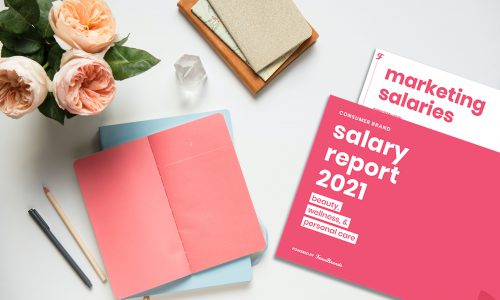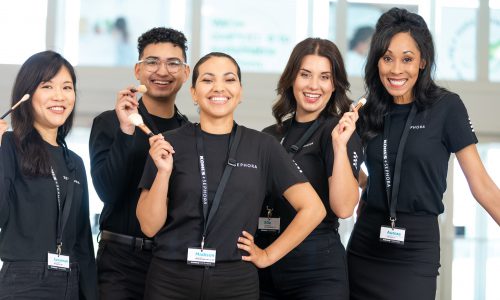The beauty boom continues to gain momentum as the overall health and wellness movement shows no signs of slowing down. The global cosmetics and skincare market alone is estimated to exceed $805 billion by 2023, and that doesn’t account for the industry as a whole that includes vitamins, dietary supplements, fragrances, household products, and more.
While clean beauty is among one of the trends defining the multidimensional beauty industry, technology is also being interwoven into the beauty narrative and has increased the demand for more beauty tech roles. As more companies look to AI, augmented reality, and machine learning, they’re hiring for roles that include digital marketing, e-commerce, and direct-to-consumer skills to keep pace with the shifting landscape.
In a candidate-driven job market, most high-growth brands are challenged with attracting the talent required to scale. And while some employers prefer to hire exclusively from within the industry and others prefer to look elsewhere, there’s one thing they can all agree on: they want candidates who have experience working for a high-growth brand and are culturally aligned with the mission and vision of the company. But that of course, can come at a cost. Instead of hiring for individual roles where candidates check each box on a job description, employers should think more broadly about the big picture and hire more creatively to meet their goals.
Hire within your means
Brands should lead with the assigned budget they have in mind for a role. This is critical because leading with title can often lead to disappointment. Oftentimes, small business owners and entrepreneurs who look for operators in an organization lead with title, unaware of the hefty price tag that comes along with it. Employers who spend too much time looking for a specific candidate to fit a predetermined role may ultimately discover the candidate’s salary expectations are not aligned with their hiring budget. With salary considerations in mind, it’s helpful to look toward smaller companies instead of larger ones where candidates are used to higher salaries and an environment rich with resources. Candidates from smaller companies are likely to be entrepreneurial, used to handling multiple tasks, and may be a better cultural fit given that they are used to working in a fast-paced environment with fewer resources.
Understanding your unique needs
Hiring needs vary depending on each stage of a brand’s growth. If a brand is scaling from infancy to $10-20 million in revenue, the hiring profile for a role is vastly different than one belonging to a brand that’s scaling from $20-100 million. For example, if a high-growth brand needs a VP of Sales, consider looking at Director of Sales candidates who are looking for the next step in their career. Making smart hiring decisions means evaluating every phase of growth. High-growth brands may not need a high-level C-Suite executive. Instead, they may benefit from hiring ‘rising stars’ over someone with years of experience. Once the business matures, it makes sense to hire for more experience.
Evaluate and streamline your business goals
Evaluation is one of the most fundamental parts of the hiring process. Brands actively hiring should take a holistic look at the business to identify where the gaps are. Evaluate the current team in place and assess how each individual’s skill set adds value to the organization. Leveraging the decision-makers in the organization, look at where you can hire from within and look at where your business is looking to expand. Identify your long-term strategy and business goals. Does your current team have those skill sets to support that growth and meet those goals? Externally, brands can improve efficiency during the interview process by narrowing down the requirements of a role to only those essential skills that are required to do the job. Before passing on a candidate’s résumé, consider how their unique skills could fit into your organization.
Offer incentives
One of the biggest misconceptions in the hiring process is that money is the only way to win over a candidate to accept an offer. But compensation isn’t the only way to remain competitive — benefits and other incentives go a long way in enticing candidates to consider changing jobs. According to ForceBrands’ 2019 Talent Market Report, an extensive in-depth analysis of cross-industry hiring trends, one of the most effective tools for employee recruitment and retention are customized benefits. In fact, more than half of the companies surveyed offer customized benefits, a trend driven by the fact that personalizing experiences has become expected from our interactions as consumers. Companies who are aware of the changing landscape of today’s job market will be better able to attract and retain talent by listening to their needs.
Mind your employer brand
When compared to other cross-industry verticals, beauty employers use social media most frequently to discover new talent. The beauty industry also ranks most likely to leverage social channels to improve their employer branding, which respondents across all industries agreed is very important in attracting and retaining talent. Brands can improve their employer branding through storytelling and offering an inside look at the people and culture of their teams. Employees should reflect the face of the brand. They’re the ones who are leading by example and can heavily influence a brand’s reputation by sharing the same mission as the visionary. In this respect, employees should be considered a long-term investment on a company’s employer brand.
When it comes to hiring, first hires are the most critical for setting a brand up for future success. Regardless of a brand’s hiring budget, investing in the right talent early can go a long way in ensuring the business has what it needs to scale.
Interested in working at an innovative beauty brand or building your beauty brand? Explore our BeautyForce division.







